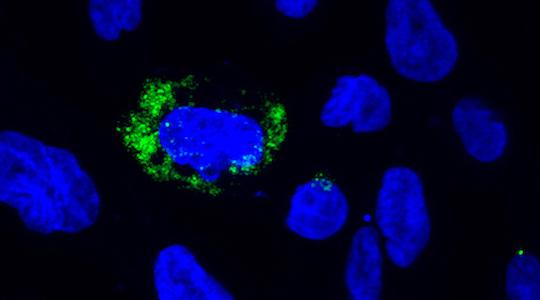CGRP, a multifaceted neuropeptide
CGRP is a potent vasodilator, mediating opposite effects in different pathologies, e.g. detrimental and elevated in migraine, while beneficial but insufficient in cardiovascular diseases. This neuropeptide is secreted from sensory peripheral pain neurons termed nociceptors, innervating all internal organs and tissues. Upon its secretion at the mucosal level, CGRP is also involved in vasodilator-independent neuroimmune interactions that directly affect the function of a variety of immune cells. Renewed interest in CGRP revealed its important unrecognized roles during infection, resulting in pathogen-dependent desired or unwanted consequences. For instance, in their previous studies, the scientists discovered that CGRP exerts significant anti-viral function: by acting on antigen-presenting Langerhans cells, CGRP strongly inhibits their infection with sexually-transmitted viruses.
CGRP is highly abundant in the airways, where it is secreted by both lung-innervating nociceptors and pulmonary neuroendocrine cells (PNECs). Due to its anti-hypertensive and anti-inflammatory effects, CGRP could converge in multiple aspects of COVID-19-related pulmonary pathophysiology.
Therapeutic potential in the fight against Covid-19
In the current study, the scientists led by Yonatan Ganor (team Mucosal Entry of HIV and Mucosal Immunity) explored whether the anti-viral function of CGRP extends to air-borne viruses, focusing on SARS-CoV-2. In collaboration with several clinicians, the scientists show that in critical COVID-19 patients, CGRP is increased in bronchoalveolar lavages (BALs). Specifically, CGRP BAL levels are elevated in early SARS-CoV-2-positive patients, and restore to baseline in late SARS-CoV-2-negative patients. The scientists further show that CGRP directly inhibits infection of the bronchial epithelial cell line Calu-3 with SARS-CoV-2 Omicron and Alpha variants, when added both pre- and post-infection. Such inhibition involves activation of the CGRP receptor, leading to down-regulation of SARS-CoV-2 entry receptors surface expression.
Collectively, the control of SARS-CoV-2 replication by CGRP suggests the induction of an endogenous and beneficial CGRP-mediated protective mechanism, similar to that observed in other lung pathologies (e.g. asthma and cystic fibrosis). Accordingly, elevated pulmonary CGRP is not causing damage but is rather a compensatory protective response, mediating beneficial SARS-CoV-2 clearance in critical COVID-19 patients. The scientists now propose that formulations containing CGRP, or inducing its secretion, could be useful for prevention and/or treatment of critical COVID-19, complementing COVID-19 vaccines and SARS-CoV-2 anti-viral medications.
CGRP inhibits SARS-CoV-2 infection. The pseudostratified bronchial epithelium consists of different types of epithelial cells such as secretory and ciliated (1), as well as PNECs (2) and innervating nociceptors (3) that are the two main cellular sources secreting CGRP in the lungs. During COVID-19, SARS-CoV-2 principally infects ciliated epithelial cells (4), leading to tissue injury and cytokine storm. The present study reveals that CGRP decreases expression of SARS-CoV-2 entry receptors in bronchial epithelial cells, subsequently inhibiting their SARS-CoV-2 productive infection (5). Accordingly, elevated CGRP observed in this study, in the lungs of SARS-CoV-2-positive critical COVID-19 patients, could mediate beneficial SARS-CoV-2 clearance.

Reference
CGRP inhibits SARS-CoV-2 infection of bronchial epithelial cells and its pulmonary levels correlate with viral clearance in critical COVID-19 patients. Caio César Barbosa Bomfim, Hugo Genin, Andréa Cottoignies-Callamarte, Sarah Gallois-Montbrun, Emilie Murigneux, Anette Sams, Arielle R Rosenberg, Sandrine Belouzard, Jean Dubuisson, Olivier Kosminder, Frédéric Pène, Benjamin Terrier, Morgane Bomsel, Yonatan Ganor. Journal of Virology. 20 August 2024, DOI: https://doi.org/10.1128/jvi.00128-24






